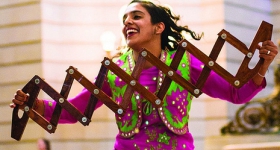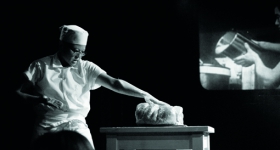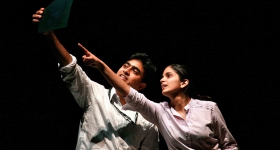This is Hyphen's last of three conversations displaying the breadth of "traditional" Asian dance forms at the San Francisco Ethnic Dance Festival. Rasika Kumar, principal dancer and choreographer of Abhinaya Dance Company of San Jose, talks about what happens when Asian American artists get together to share ... and strut their artistic stuff!
Synergy is a collaboration between Abhinaya Bharatanatyam dancers and San Jose Taiko drummers, under the direction of incoming artistic director Franco Imperial. The piece promises to be a true conversation of rhythm, a work that emphasizes the universal in both their artistic practices, without deviating from the requirements of their respective genres.
Read on to learn about Rasika and Franco's artistic processes, how they step up to become the artistic visionaries for both their companies, and Rasika's personal take on cultural fusion as it differs from conversation.
Hello, Rasika! So, what I see here is that your group, Abhinaya Dance Company of San Jose, is working with San Jose Taiko to create this year’s piece, Synergy. How did this come together in the first place? Can you give us a little background?
It actually goes back to the 1990s! Abhinaya was founded in the 1980 and San Jose Taiko was founded in 1973. In 1993, they did their first collaboration called In the Spirit. It was a really amazing production. The theme of it was conversation. It posed the question “Who are you guys?” It showed [initial] rejection of difference, and then learning and mutual acceptance.
It really reflected what was going on in the community at the time. Groups were focused on themselves. But learning to open up, learning about each other, and then learning to collaborate made the San Jose arts community really rich.
I was very young at the time, so I wasn’t a part of it. But I saw it, and I was blown away. Our two groups didn’t collaborate much after that. But we kept in touch, and then last year was Ahbinaya’s 30th anniversary. So my mother [Abhinaya’s current artistic director, Mythili Kumar] applied to grants that would support collaboration with past collaborators. San Jose Taiko was one of them, and part of the collaboration’s intent this time was to promote the next generation of artistic directors and thinkers.
So the torch was passed for this collaboration [to me and Franco Imperial]. This piece is our version of what collaboration is between our two companies. (It’s not a fusion; it's collaboration.)
We started from scratch. We paid a little tribute to the original production, but we came up with a whole new vision. There is no real story this time. What resulted was a piece last August, about thirty-five minutes, with fun interactions between dancers and drummers. We had characters, tones, rhythms, and technicality that a lay person would not be able to do.
Since you are the choreographer for your dance company, and a part of a new generation of dance makers, what are you trying to say that is different? How does this collaboration differ from the original?
This time, we use more of a full artistic expression. The theme in 1993 -- does that apply to us? I was born here, so was Franco. We’re American, and we’re not as concerned with our differences. We grew up like this. We want to find out what’s in common. So our similarities were the rhythm patterns. We exploited those, because they were the same. Second, it was the spirituality. Both traditions have spirit and intent in how you move. ... This year, we are more about understanding our similarities.
You mentioned that this was a collaboration and not fusion? I’m interested in that statement. What do you mean by that, especially since we are talking about similarities?
Well, fusion would be if I were doing both. But it’s not that. It’s pure Taiko, and pure Bharatanatyam. It’s back and forth, an interplay of rhythms, call and response.
Say more about the collaborative process. How did you implement it to achieve this “interplay of rhythms”?
I actually composed several rhythms. I listened to Taiko drumming, and then I wrote rhythm patterns that are Indian rhythm patterns. Franco had a Taiko piece that he taught to me, the rhythm pattern. And then I translated it into steps. So he taught me one of their sequences, and I created one for them. It was lots of back and forth, and I really enjoyed the collaboration. We did it all without having to break rules [of our genres] or make things uncomfortable or awkward.
This is a real conversation, not two separate sides. It’s us really coming together. ... We have so much in common. The rhythms in our feet and the tapping rhythms in the drums... Our two traditions developed separately over thousands of years, and yet there is something universal about rhythm that we’re really tapping into [in this piece].
This could not be accomplished if it was fusion?
I emphasize that this is not fusion is because I’m trained in Bharatanatyam. To claim that I could perform Taiko would be disrespectful. I haven’t spent years studying it. We have a lot of respect for our own traditions, so we need to extend that to others' traditions. It’s definitely not something someone could just come in and do, and vice versa.
In my opinion, fusion is when one person performs several styles simultaneously, and I don’t like to do it unless one person is well versed in several styles. We do what we are trained to do, and they are doing the same. So it’s a conversation.
What do you want us, as audience members, to take away from your piece?
"Wow, that looks fun!" So much of why we dance, and the same goes for the Taiko drummers, is to inspire and bring joy to people. It’s all in how it looks, how it feels, how it makes other people feel. This is common to both our traditions, that underneath it all, everything should be really electrifying and fun.
Also, it’s just so exciting! There is so much stuff that we’ve worked on! I think it’s very technical. It’s constant back and forth. We’ve practiced so hard to make it this thing where you don’t know what’s going to happen next!
You [the audience] won’t know what’s going to happen, or how we’re going to interact. You’re going to think we’re going one way, but then we go somewhere totally different. It’s incredible movement coordination. Who would have thought, when they strike the drum, that we could do something that’s totally aligned with it. And there’s lots of musical interaction. Our company has freelance musicians who work with us. The Japanese flute player ends on this one note… and, a note is a note! Our flutist picks up on it. The frequency of sound is the same no matter what instrument or tradition! It transitions seamlessly. We both use a 4/4 time scale. That’s the same for us. We both work within it, and I’ve found that the possibilities are endless within that time scale.









Comments